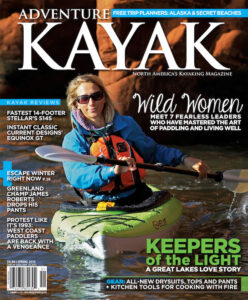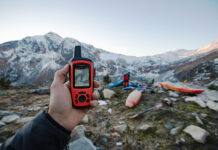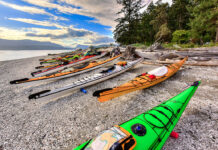Sea kayaking has always been strong on tradition. Paddlers revive old Inuit techniques, build boats from designs in museums, and retrace long-ago expeditions. But we have another important tradition that we neglected until recently: being a force for conservation.
In 1954, a paddler and retired chemistry professor named Harold Bradley teamed up with a group of river runners to save the Yampa River from dams in what is now Dinosaur National Monument. The campaign transformed a modest outdoor club into a household name in conservation: they’re called the Sierra Club. A decade later, river guide Martin Litton led a campaign to keep dams out of the Grand Canyon.
More recently, in 1993, sea kayakers joined forces with environmentalists and First Nations to save Vancouver Island’s Clayoquot Sound from wholesale logging. The protests marked the largest act of civil disobedience in the nation’s history, and preserved what is now one of the world’s best-known paddling meccas.
Then conservation abruptly disappeared from the paddling community’s agenda. Kayakers turned inward, focusing narrowly on the sport. In 2006, I was even told by a local paddling club that I couldn’t make an announcement about a campaign to protect natural areas, because it might be “divisive.”
Why the retreat? Ironically, one reason was success. Led by the likes of Litton, Bradley, David Brower and Edward Abbey, with roots firmly in outdoor exploration, the first wave of conservation won major victories in the ‘60s and ‘70s. Those victories created environmental laws that relied on science and legal action for enforcement. The need was suddenly for ecologists and lawyers who could appeal timber sales, file Clean Water Act suits, and protest obscure agency procedures.
About the same time, the sport of kayaking was growing and manufacturers and clubs found themselves maneuvering for customers and members. In this increasingly competitive environment, many feared alienating one side of the conservation debate.
After a two-decade hiatus, however, kayakers are re-embracing the art of advocacy. Conservation groups reached the limit of what they could achieve through law and science alone, and returned to mobilizing passionate people. In Portland, paddlers made headlines in 2012 by arranging their crafts into a giant “350” on the river (the amount of carbon dioxide the atmosphere can tolerate without cataclysm). From student Anna Gleizer’s 2012 circumnavigation of Siberia’s Lake Baikal to study water quality and climate effects, to the Sitka Conservation Society’s trips to survey wilderness areas and watchdog timber sales, paddling and advocacy have merged once more.

We’ve also made the leap from raising awareness and collecting data to the hard-nosed work of changing policy. Letters and emails from paddlers helped shift the Forest Service from logging toward wilderness protection in Alaska and pushed a river-mining moratorium in Oregon.
Modern paddler-activists have another powerful tool at our disposal: the technological democracy of the Internet. One example is Out of Sight, Out of Mind, a marine debris campaign created on the cheap by kayak instructors using Facebook and Kickstarter.
In the next few years, I predict that kayakers’ resurgent conservation ethic will find the sweet spot between freewheeling awareness-raising and more coordinated strategies needed to create marine reserves, regulate pollution and pressure policymakers.
Back in British Columbia, paddlers of all stripes are once again on the frontlines of a pivotal battle. The stakes are every bit as high as in ‘93: the Enbridge Northern Gateway pipeline to Kitimat would transform the wild Central Coast into a tanker freeway vulnerable to a Valdez-size oil spill. The lost tradition has returned just in time.
Longtime contributor Neil Schulman celebrates kayaking’s diverse heritage in Reflections.








